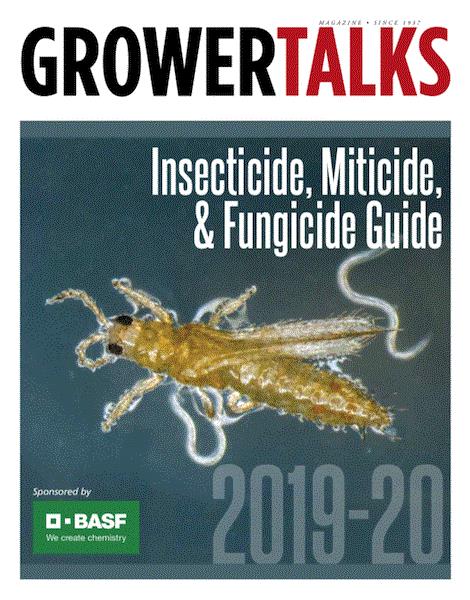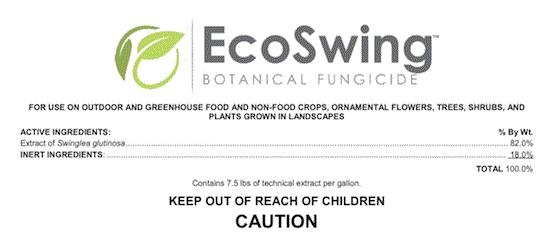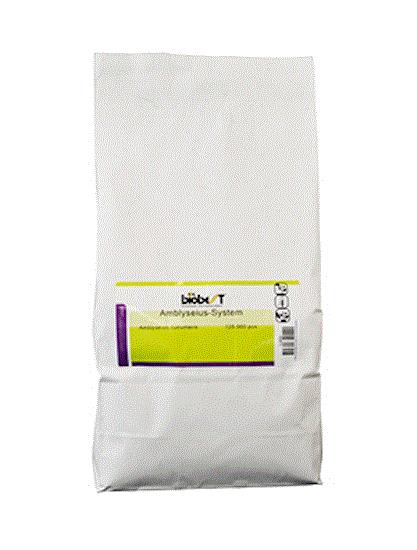Drum roll … The New GrowerTalks Pesticide Guide is Out
The biggest news this week is the publication of the 2019-2020 GrowerTalks Insecticide, Miticide & Fungicide Guide. Yes, I’m biased, but you can’t blame a guy who is excited.
The guide is sponsored by BASF, with listings of pesticides for insects, mites and diseases that are bugging you. The guide also contains articles on disease information, whiteflies, pesticide rotation, maximizing pesticide efficacy, Intrinsic brand fungicides and fall disease prevention written by Ann Chase, Ray Cloyd, Kathie Kalmowitz and yes, yours truly.
I use this guide frequently, and the articles included in the guide are also very useful. Click here to get a pdf copy, hot off the presses!

EcoSwing—a New Botanical Fungicide from Gowan
There are a couple of product news items I want to share with you this week.
First, Gowan launched a new botanical fungicide, EcoSwing, in mid-October. EcoSwing is now registered in all U.S. states (except Alaska) with registration pending in California, Florida, Puerto Rico and New York.
EcoSwing is a liquid fungicide containing extract from the leaves of Swinglea glutinosa, a citrus species found in Southeast Asia and South America, commonly known as tabog in the Philippines. This product is listed for organic production, but not yet certified by OMRI.

Fungal diseases targeted by EcoSwing include alternaria leaf spot, black sigatoka, brown rot, blossom blight, bunch rot, powdery mildew, soft rot (erwinia), sour rot and stem-end rot complex. According to the EPA registration information filed by Gowan, the mode of action of EcoSwing is unknown, but the terpene constituents in the essential oils of the extract likely cause fungal cell membrane disruption.
EcoSwing is registered for use on food and non-food crops in outdoor and greenhouse production, including ornamentals, berries, small fruits, tree nuts, herbs, vegetables, hops, mint, grains and oilseeds. Use rates range from 1.5 to 2 pints per 100 gallons (for ornamentals) or 1.5 to 2 pints per acre (for other crops). The restricted reentry interval (REI) is 4 hours, and the pre-harvest interval is 0 days.
Biobest’s Redesigned Amblyseius Packaging
If y’all are buying bulk Amblyseius-Systems from Biobest, you’ll notice the predatory mites now come in different packaging. Biobest has replaced its original plastic bucket for the bulk packaging with an eco-friendly paper bag. According to Biobest, the goal is to reduce reliance on plastic.
Biobest will start to ship Amblyseius cucumeris in the new paper bag packaging this week, and will gradually replace plastic packaging for other predatory mite species. The quality of the predatory mites will not be affected.

EAB Story Map
Y’all know the emerald ash borer, or EAB, right? You know, that little emerald green flathead borer that has killed millions of ash trees in 35 states and the District of Columbia?
USDA APHIS has developed a new interactive tool, called EAB Story Map, to educate the public on the efforts to contain and control EAB since the invasive pest’s detection in Michigan in 2002. The tool contains information on the damage, survey, quarantine and management of EAB. The tool also shows the spread of EAB from 2002 to the present, with lots of pictures and useful information.
In early November, APHIS proposed the lifting of domestic quarantine against EAB. The plan is to reallocate funding for implementation and enforcement of quarantines to research and deployment of biological control agents. APHIS is currently reviewing the public comments received until the close of the comment period on November 19. The agency is also committed to continue surveying efforts on the leading fronts of the spread of EAB, releases of biological control agents and public outreach.
Nematode Webinar
No, not the plant-infesting kind, silly. I meant the biological control kind. But, having a plant parasitic nematode webinar wouldn't be a bad idea, though.
Suzanne “Buglady” Wainwright and Julie Graesch will present a webinar about beneficial nematodes on December 13, 1:00 PM Eastern Time. I don't need to introduce Suzanne; y’all know her. Julie is a scientist with BASF. Suzanne and Julie will share information and their experiences with using entomopathogenic nematodes to control thrips, fungus gnats and shore flies.
I often think of entomopathogenic fungi and nematodes as gateway drugs to biological control—try ‘em, you’ll like ‘em, and want more of ‘em. Heck, the new GrowerTalks pesticide guide even uses a picture of nematodes oozing out of a thrips as the front cover. Yes, nematodes are easy to use and effective, but there are still little tricks you can do to improve their effectiveness. Whether you are thinking about using beneficial nematodes, or have been using beneficial nematodes for years, this is a webinar you don't want to miss.
This webinar is part of the GrowerTalks webinar series, sponsored by BASF and is available to you for free. Click here to register for the webinar.
Participate in the Floriculture Crop Survey
Feeling generous this holiday season? Want to get gold instead of coal in your stocking for a change? Here are a couple of opportunities for you to fill the world (okay, maybe just those nice folks at USDA) with joy!
USDA’s National Agricultural Statistics Service will reinstate the Floriculture Crops Summary Survey in 2019. The last survey was conducted in 2015 and involved over 10,000 commercial floriculture operations in 15 states. The 2019 survey will be sent by mail to growers in 17 states later this month.
If you are one of the lucky 15,000 that receive a survey, please take some time to fill it out. I know, I know, y’all have tons of other things to worry about—in-laws staying with you, spring crops, where you last saw Grandma’s secret eggnog recipe. But, this survey is very important for us to assess the state of our industry and plan for its future.
Ellen Wells’ Tropical Topics this week gave a list of great reasons (from Marvin Miller) for participating in this survey: know where your operation stands compared to your peers, plan your pricing, and plan your volume. Here is a reason closer to my heart: Let’s show our legislators and decision makers at federal agencies that the floriculture industry is as productive and valuable as corn, soybean, cotton or hogs (to name a few), and therefore, deserves as much support as other agricultural commodities. We are not stepchildren.
Oh, excuse me, did I sound a wee bit bitter?
Don't be disappointed if you did not receive a survey in the mail. It’s not that USDA doesn't care about you or blows your operation off; you just don't live in one of the 17 states, or you are not selected from among many.

Volunteer for SCRI’s Industry Relevance Review Panel
This second Brownie-point earning opportunity is going to be fun because you can say “yea” or “nay” to research proposals someone spent weeks putting together. Very powerful position for an egomaniac like me, or for someone who just wants to have a seat at the table.
You can volunteer to serve as an expert reviewer of industry relevance for grant proposals submitted to USDA’s Specialty Crop Research Initiate (SCRI). Anyone who works in the horticultural industry—grower, landscape care professional, retailer, buyer or distributor—can participate in the panel. The job of the Industry Relevance Review Panel is to evaluate if a proposal meets the urgent or critical needs of the specialty crop industry and select a handful of pre-proposals that will be invited to be submitted as full proposals.
I’ll give y’all a little background on the SCRI proposal submission process. Researchers, usually working in teams, prepare short pre-proposals outlining their research ideas. An important part of the pre-proposal is a Stakeholder Relevance Statement (four to seven pages), which explains how the proposed project addresses industry needs and is expected to be impactful. The Industry Relevance Panel reviews the Stakeholder Relevance Statements and decides who goes to the next round.
SCRI is a multi-million dollar program that receives more than one hundred pre-proposals from money-hungry researchers each year. But, only a few dozens of these pre-proposals are selected for full proposal submission. You are right to think that the Industry Relevance Panel is important and powerful because it is the “gatekeeper” that weeds out proposals. Serving on this panel is an excellent and exciting way to make an impact on how and which topics receive funding. It’s okay to have a favorite topic you want to fight for because competition among stakeholders is part of the process. So, you want to see more research funding going to the green industry, or your segment of the industry? Then, serve on the panel and fight for it.
It won't take too much of your time to serve on the panel, perhaps a total of 10 to 25 hours. You’ll be assigned to a specific topic panel that is closest to your background, and be tasked with reviewing up to 15 Stakeholder Relevance Statements. You’ll then rank and comment on these statements using an online system, and participate in a one-hour conference call with other reviewers in your topic panel to agree on the consolidated ranking. This is also a chance for you to get to know your peers, some of them movers and shakers of the industry.
Contact Dr. Tom Bewick, the national program leader of SCRI, for information or to volunteer.
I asked my wife this morning about my chance of getting a new outboard motor in my stocking, since I promised to be a good boy (Yes, better than our youngest, Andrew!) and volunteer for the above activities when called upon. My wife snorted coffee out of her nose, as if hearing something ridiculous or dumb, and said, “Good luck convincing Santa Sake (her dog).”






See y'all next time!

JC Chong
Associate Professor of Entomology at Clemson University
This e-mail received by 24,770 subscribers like you!
If you're interested in advertising on PestTalks contact Kim Brown ASAP!